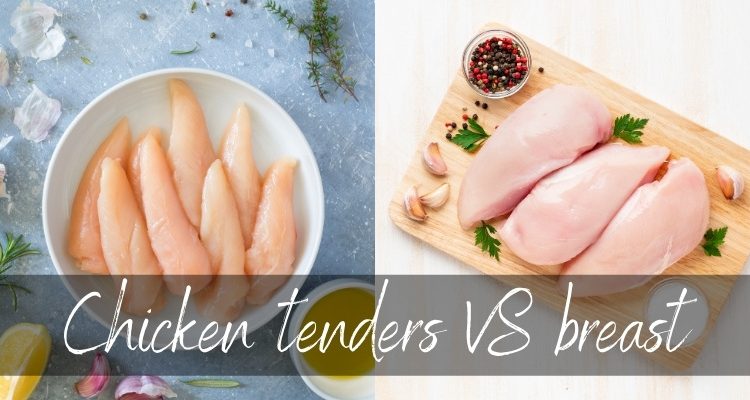
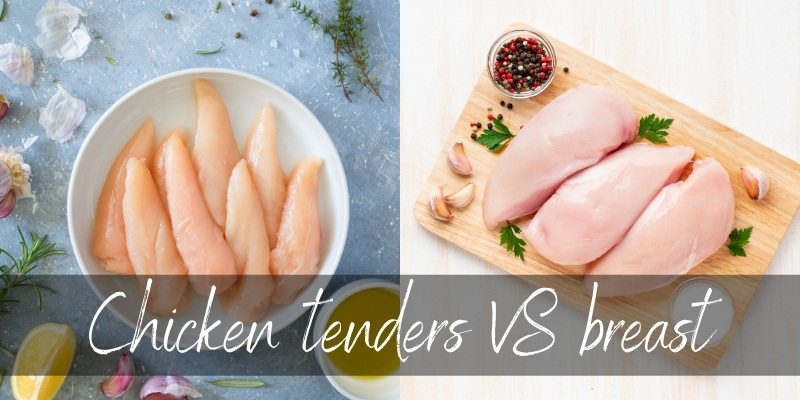
As food enthusiasts and kitchen explorers, we are constantly seeking the perfect balance of flavor, tenderness, and versatility in our dishes.
And when it comes to poultry, the battle between tenderloin and breast cuts has ignited passionate discussions among cooks and foodies alike.
Diving deep into the characteristics, cooking methods, and unique qualities of both chicken tenderloin and chicken breast.
The chicken tenderloin, with its slender and succulent profile, has been praised for its tenderness and ability to cook quickly.
On the other hand, the chicken breast, a timeless classic, is known for its heartiness and widespread use in a plethora of recipes.
But which cut truly reigns supreme in the culinary world? Which one deserves the title of “The Best Cut”?
We will explore their differences and similarities, their nutritional value, and how they respond to various cooking techniques.
Whether you’re a seasoned chef looking to expand your poultry repertoire or a curious home cook seeking to master the art of chicken, join us as we unravel the secrets behind these two popular cuts and help you decide which one is the ultimate winner for your kitchen creations.
How Do Chicken Tenderloin And Breast Differ?
Chicken tenderloin and chicken breast are both popular cuts of poultry, each with its own unique characteristics and culinary applications. Let’s delve into their differences to better understand how they stand apart from each other:
Location and Size
The chicken tenderloin, also known as the chicken tender or tenderloin strip, is a small, thin strip of meat located on the underside of the chicken breast. It is a part of the breast meat and is generally more tender and delicate in texture. On the other hand, the chicken breast is the larger, main portion of meat
from the chest of the chicken, known for its substantial size and heartier texture.
Texture and Tenderness
Chicken tenderloins are revered for their exceptional tenderness. As they come from a less-used muscle group and contain less connective tissue, they have a soft and succulent texture when cooked properly. Conversely, chicken breast meat is lean and can be tender when cooked correctly, but it can also become dry and tough if overcooked due to its lower fat content.
Cooking Time
Due to its smaller size and delicate nature, chicken tenderloin cooks relatively quickly, making it an ideal choice for dishes that require fast cooking times, such as stir-fries, skewers, and quick sautés. Chicken breast, being thicker and more substantial, requires a bit more cooking time and may be better suited for roasting, baking, grilling, or slow-cooking to ensure it stays moist and tender.
Flavor
Both cuts offer a mild and versatile flavor that can be easily influenced by various seasonings and marinades. The chicken tenderloin’s tenderness allows it to absorb flavors more readily, while the chicken breast’s larger size gives it a slightly meatier taste.
Culinary Versatility
While chicken tenderloins are excellent for finger foods, appetizers, and dishes where tenderness is the priority, chicken breasts are incredibly versatile and can be used in an extensive range of recipes. From salads and sandwiches to pasta dishes and hearty mains, the chicken breast’s size and texture make it a go-to choice for many different cuisines and cooking styles.
Nutritional Differences
Nutritionally, both cuts are relatively lean, but the chicken breast tends to be lower in fat and calories compared to the tenderloin.
However, the differences are not significant, and both cuts provide a good source of protein and essential nutrients.
The choice between chicken tenderloin and chicken breast comes down to personal preference and the specific requirements of the dish you’re preparing.
Whether you’re aiming for delicate tenderness or heartier satisfaction, both cuts have their place in the culinary world and can lead to delightful dining experiences when cooked with care and creativity.
Basic Information About Chicken Tenderloin And Breast
Chicken Tenderloin
Location
Chicken tenderloin is a small, thin strip of meat located on the underside of the chicken breast. It is part of the breast meat and can be found attached to the larger breast portion.
Size and Shape
Tenderloins are relatively small, typically measuring a few inches in length and about an inch or two in width. They have a long, slender shape.
Texture and Tenderness
Chicken tenderloins are known for their exceptional tenderness and soft texture. Due to their location and minimal connective tissue, they are one of the most tender parts of the chicken.
Cooking Time
Because of their small size and tenderness, chicken tenderloins cook quickly, making them suitable for fast cooking methods like sautéing, grilling, and stir-frying.
Culinary Uses
Chicken tenderloins are often used in dishes where quick cooking and tenderness are desired, such as chicken tenders, skewers, fajitas, salads, and various appetizers.
Chicken Breast
Location
Chicken breast is the larger, main portion of meat from the chest of the chicken. It is located on the front of the bird, and each chicken typically has two breasts.
Size and Shape
Chicken breasts are more substantial compared to tenderloins, and their size can vary depending on the size of the chicken. They have a thick and flat shape.
Texture and Tenderness
Chicken breast meat is lean and can be tender if cooked properly. However, it can also become dry and tough if overcooked due to its lower fat content.
Cooking Time
Due to their thickness, chicken breasts may require longer cooking times, especially when prepared whole or in thicker cuts. Common cooking methods include baking, roasting, grilling, and poaching.
Culinary Uses
Chicken breasts are incredibly versatile and can be used in a wide range of dishes. They are popular in salads, sandwiches, pasta dishes, curries, casseroles, and many other recipes.
Nutritional Information (per 3-ounce cooked portion):
- Chicken Tenderloin: Approximately 120-150 calories, 26-30 grams of protein, 1-3 grams of fat.
- Chicken Breast: Approximately 140-170 calories, 24-26 grams of protein, 3-5 grams of fat.
Both chicken tenderloin and chicken breast are excellent sources of lean protein and offer various health benefits.
When cooking either cut, it’s essential to monitor the cooking time to achieve the desired level of tenderness and juiciness.
Whether you prefer the delicate tenderness of tenderloins or the heartier texture of chicken breast, both cuts can make for delicious and nutritious meals when prepared with care and paired with the right ingredients and seasonings.
Few Things In Common Between Chicken Tenderloin and Breast
While chicken tenderloin and chicken breast have some distinct differences, they also share a few common characteristics. Here are some things they have in common:
Poultry Origin
Both chicken tenderloin and chicken breast come from the same bird, the chicken. They are both cuts of meat obtained from the chest area of the chicken.
Lean Protein Source
Both cuts are excellent sources of lean protein. They provide essential amino acids necessary for building and repairing tissues in the body. As lean proteins, they are popular choices for individuals seeking to maintain a healthy diet and manage their weight.
Mild Flavor
Chicken tenderloin and chicken breast have mild, neutral flavors. This characteristic makes them versatile ingredients in various recipes because they can easily absorb and complement a wide range of seasonings, marinades, and sauces.
Versatility in Cooking
Both cuts offer a great deal of culinary versatility. While chicken tenderloin is often used for quick-cooking methods like stir-frying and grilling, and chicken breast is commonly baked, roasted, grilled, or poached, both can be prepared using a variety of cooking techniques based on personal preference and the desired outcome of the dish.
Nutritional Benefits
Chicken tenderloin and chicken breast are low in saturated fat and cholesterol while being rich in essential nutrients such as niacin (vitamin B3), vitamin B6, phosphorus, and selenium. They also contain important minerals like iron and zinc, making them valuable components of a balanced diet.
Wide Culinary Application
Both cuts are staples in many cuisines around the world. Whether it’s a classic chicken breast sandwich or tenderloin skewers with a delightful dipping sauce, both cuts can star in a multitude of dishes and cater to various culinary preferences.
Health Conscious Choice
For those looking to reduce fat intake without sacrificing protein intake, both chicken tenderloin and chicken breast are smart choices. Their lean nature aligns well with health-conscious diets and can contribute to a balanced and nutritious meal plan.
Despite their differences in tenderness, size, and cooking times, chicken tenderloin and chicken breast are both valuable components of a diverse and healthy diet.
Their shared qualities make them essential ingredients in a wide array of dishes and ensure that no matter which cut you choose, you’ll be treated to a delicious and nutritious poultry experience.
Chicken Tenderloin vs. Breast: A World Of Difference
When it comes to the world of poultry, few cuts spark as much culinary debate as chicken tenderloin and chicken breast. While they both originate from the same bird, the differences between these two cuts create a flavorful showdown that sets them apart in various aspects. From taste and texture to cooking methods and versatility, let’s explore the world of difference between chicken tenderloin and breast.
Texture and Tenderness
Chicken Tenderloin: As its name suggests, the tenderloin boasts unparalleled tenderness. Located on the underside of the breast, this strip of meat is known for its delicate, melt-in-your-mouth texture. Its tenderness makes it a popular choice for quick-cooking methods like stir-frying and grilling.
Chicken Breast: The breast, on the other hand, is a larger and more substantial cut of meat. While it can be tender when cooked correctly, it requires a bit more finesse to avoid becoming dry and tough. Its heartier texture lends itself well to roasting, baking, and other slower cooking methods.
Cooking Time
Chicken Tenderloin: Thanks to its small size and tender nature, the tenderloin cooks quickly, making it perfect for dishes where time is of the essence.
Chicken Breast: Due to its thickness, chicken breast may need more cooking time to ensure it is fully cooked and remains juicy. This makes it ideal for recipes that allow for longer cooking processes, such as oven-baked dishes or slow-cooked stews.
Flavor Profile
Both cuts offer a mild, neutral flavor that can easily adapt to various seasonings, marinades, and sauces. The chicken tenderloin’s tenderness allows it to absorb flavors readily, while the larger chicken breast offers a slightly meatier taste.
Culinary Versatility
Chicken Tenderloin: Its tenderness and quick cooking time make the tenderloin an excellent choice for dishes that require delicacy and swift preparation. Think finger foods, appetizers, and light entrees.
Chicken Breast: The versatility of the chicken breast knows no bounds. Its larger size and heartier texture allow it to shine in a vast array of recipes, from salads and sandwiches to pasta dishes, curries, and hearty mains.
Nutritional Content
In terms of nutrition, both cuts provide a good source of lean protein, making them favorable options for health-conscious individuals. The chicken breast generally contains slightly fewer calories and less fat than the tenderloin due to its leaner nature.
The choice between chicken tenderloin and breast depends on your desired outcome, preferred cooking method, and the flavors you wish to explore.
While the tenderloin offers unbeatable tenderness and rapid cooking, the breast brings a heartier texture and exceptional culinary versatility to the table.
So, whether you’re in the mood for a quick and delicate dish or a robust and satisfying meal, the world of difference between these two cuts promises to elevate your culinary experiences to new heights.
Where They Are Located ?
Chicken tenderloin and chicken breast are located in different areas of the chicken’s anatomy:
Chicken Tenderloin
Location: Chicken tenderloin, also known as the tender or tenderloin strip, is found on the underside of the chicken breast. It is a thin, elongated strip of meat.
How to Identify: To locate the tenderloin, you can turn the chicken breast over and look for a small, separate piece of meat running along the inner edge of the breast. It is usually attached to the breast meat and can be removed with a little bit of careful trimming.
Chicken Breast
Location: The chicken breast is the large, main portion of meat from the chest of the chicken. It is situated on the front of the bird and is one of the primary cuts of poultry.
How to Identify: Chicken breasts are relatively easy to identify as they are the prominent meaty sections on either side of the chicken’s chest. Each chicken has two breasts.
How They Look
Chicken Tenderloin
Appearance: Chicken tenderloins are small, thin, and elongated strips of meat. They typically have a pale pinkish color and a smooth texture.
Size: The size of chicken tenderloins can vary, but they are generally smaller compared to chicken breasts. Each tenderloin is usually a few inches in length and about an inch or two in width.
Location: Chicken tenderloins are located on the underside of the chicken breast, running along the inner edge of the breast. They are attached to the larger breast portion and can be separated with a bit of careful trimming.
Chicken Breast
Appearance: Chicken breasts are more substantial and have a thicker, flatter appearance compared to chicken tenderloins. They have a pale pink or white color with a smooth and slightly textured surface.
Size: Chicken breasts are larger cuts of meat, and their size can vary depending on the size of the chicken. On average, a single chicken breast can be around 5 to 8 inches in length and about 3 to 5 inches in width, depending on the bird’s size.
Location: Chicken breasts are situated on the front of the chicken’s chest, and each chicken has two breasts. They are the prominent meaty sections on either side of the breastbone.
How Big They Are
Chicken Tenderloin:
Length: On average, chicken tenderloins are around 2 to 4 inches in length.
Width: The width of chicken tenderloins is typically about 1 to 2 inches.
Chicken Breast:
Length: A whole chicken breast, which includes both halves (left and right), can range from approximately 5 to 8 inches in length.
Width: The width of a chicken breast is usually around 3 to 5 inches.
Keep in mind that these measurements are approximate and can vary based on factors such as the age and size of the chicken.
Some chicken breasts may be sold as boneless, skinless halves, while others might be sold as bone-in with the skin on.
These variations can also affect the overall size and weight of the chicken breast.
How They Feel When Cooked
When cooked properly, chicken tenderloin and chicken breast can have different textures and sensations:
Cooked Chicken Tenderloin
Texture: Chicken tenderloins are incredibly tender and delicate when cooked properly. They have a soft, almost buttery texture that melts in your mouth.
Moisture: Due to their tenderness and relatively low fat content, cooked chicken tenderloins can be moist and juicy if not overcooked.
Cooked Chicken Breast
Texture: When cooked correctly, chicken breast can be tender, but it has a heartier texture compared to tenderloins. It is firmer and less delicate than the tenderloin.
Moisture: Because chicken breast contains less fat compared to other cuts, there is a risk of it becoming dry if overcooked. Properly cooked chicken breast should retain moisture and juiciness.
It’s crucial to cook chicken tenderloin and chicken breast to the appropriate internal temperature to ensure both safety and optimum taste and texture.
Overcooking either cut can result in dry and tough meat, particularly in the case of chicken breast due to its lean nature. Using a meat thermometer to check the internal temperature is a reliable way to determine when the chicken is fully cooked while maintaining its desired texture and juiciness.
When you master the art of cooking chicken tenderloin and chicken breast to perfection, you can savor the delightful tenderness of the tenderloin and the satisfying heartiness of the breast, creating a delectable dining experience with each bite.
How They Taste
The taste of chicken tenderloin and chicken breast is quite similar due to their shared origin from the same bird. However, there are subtle differences in flavor and texture that discerning palates can detect:
Chicken Tenderloin
Taste: Chicken tenderloin has a mild and delicate flavor. Its tenderness allows it to readily absorb the flavors of marinades, seasonings, and sauces, making it a perfect canvas for various culinary creations.
Texture: As mentioned earlier, chicken tenderloin is incredibly tender and soft when cooked properly. Its fine texture contributes to a pleasant mouthfeel.
Chicken Breast
Taste: Chicken breast also has a mild flavor, but it might have a slightly meatier taste compared to chicken tenderloin due to its larger size and thicker texture.
Texture: When cooked correctly, chicken breast can be tender, but it is generally more substantial and less delicate than the tenderloin. Its texture is firmer, and it offers a more substantial bite.
It’s important to note that both cuts can become dry and less flavorful if overcooked, so proper cooking techniques are essential to retain their natural taste and tenderness.
The use of marinades, seasonings, and cooking methods can further enhance the flavor of both chicken tenderloin and chicken breast, allowing you to create a wide variety of delicious dishes to suit your palate preferences.
While chicken tenderloin and chicken breast have some differences in taste and texture, both cuts offer a mild and versatile flavor profile.
Their unique characteristics make them valuable ingredients in a wide range of recipes, and their tastes can be enhanced and customized based on the culinary techniques and seasonings used during preparation.
Versatility In Cooking
Both chicken tenderloin and chicken breast are highly versatile cuts of poultry, offering a wide range of cooking options to suit various culinary preferences. Their adaptability in the kitchen makes them popular choices for home cooks and professional chefs alike.
Chicken Tenderloin
Quick Cooking: Chicken tenderloin’s small size and tenderness make it ideal for quick-cooking methods. It cooks rapidly, saving time in the kitchen and allowing you to prepare delicious meals in a pinch.
Stir-Frying: Tenderloins are perfect for stir-frying, as they cook quickly and absorb flavors readily from sauces and seasonings.
Grilling and Sautéing: Tenderloins are well-suited for grilling or sautéing, giving them a beautiful charred exterior while maintaining their tenderness.
Kebabs and Skewers: Their slender shape makes them excellent candidates for kebabs and skewers, providing bite-sized delights that are easy to handle and cook evenly.
Chicken Breast
Baking and Roasting: Chicken breast is often baked or roasted to perfection, maintaining its moisture and developing a lovely golden-brown exterior. This method allows for various seasonings and marinades to be applied to enhance the flavor.
Grilling and Barbecuing: Grilling or barbecuing chicken breast adds a smoky flavor while creating grill marks and caramelization on the meat’s surface.
Pan-Frying and Sautéing: Chicken breast can be pan-fried or sautéed with a variety of coatings or sauces, giving it a delicious crispy exterior.
Poaching and Slow-Cooking: For tender and juicy results, chicken breast can be poached or prepared in slow-cooker recipes, absorbing flavors from the liquid it’s cooked in.
Both cuts lend themselves well to countless recipes, ranging from salads, sandwiches, and pasta dishes to curries, casseroles, and more.
Their versatility means you can explore various cuisines, cooking techniques, and flavor profiles, ensuring that you’ll never run out of creative ways to enjoy chicken in your meals.
Whether you’re aiming for a quick and light meal with tenderloins or preparing a hearty and satisfying dinner with chicken breast, the versatility of these cuts allows you to craft a diverse array of dishes to suit every occasion and taste preference.
How Nutritious They Are
Both chicken tenderloin and chicken breast are nutritious sources of lean protein and offer various essential nutrients. However, there are slight differences in their nutritional content:
Chicken Tenderloin (per 3-ounce cooked portion)
Calories: Approximately 120-150 calories
Protein: About 26-30 grams
Fat: Approximately 1-3 grams
Cholesterol: Around 75-85 milligrams
Vitamins and Minerals: Chicken tenderloins provide essential nutrients such as niacin (vitamin B3), vitamin B6, phosphorus, and selenium. They also contain small amounts of iron and zinc.
Chicken Breast (per 3-ounce cooked portion)
Calories: Approximately 140-170 calories
Protein: About 24-26 grams
Fat: Approximately 3-5 grams
Cholesterol: Around 70-80 milligrams
Vitamins and Minerals: Chicken breast is a good source of nutrients, including niacin (vitamin B3), vitamin B6, phosphorus, selenium, iron, and zinc.
Both cuts are relatively low in saturated fat and cholesterol, making them excellent choices for those aiming to maintain a balanced and health-conscious diet.
They provide high-quality protein, which is essential for muscle repair and growth, as well as other bodily functions. Additionally, the vitamins and minerals found in both chicken tenderloin and chicken breast contribute to overall health and well-being.
When preparing these cuts, cooking methods can impact their nutritional content. For the healthiest results, consider grilling, baking, roasting, or poaching the chicken, as these methods require less added fat compared to frying.
Pairing chicken with a variety of nutrient-rich vegetables and whole grains can create a well-rounded and nutritious meal.
As with any food, portion size and overall dietary balance are crucial factors to consider.
Incorporating chicken tenderloin or chicken breast into a well-rounded diet that includes a variety of fruits, vegetables, whole grains, and other protein sources can help you maintain a healthy lifestyle and enjoy the nutritional benefits of these versatile and delicious poultry cuts.
How They Cost
The cost of chicken tenderloin and chicken breast can vary depending on several factors, including the location, the quality of the meat, and any additional processing or packaging.
Chicken Tenderloin
Chicken tenderloins can be considered a premium cut of chicken due to their tenderness and popularity. As a result, they are more expensive compared to other chicken cuts.
When sold separately as individual tenderloins, they may have a higher price per pound compared to purchasing a whole chicken breast.
Chicken Breast
Chicken breasts are widely available and considered one of the most popular cuts of chicken. Their popularity often makes them more affordable than tenderloins.
You can typically find chicken breasts sold boneless and skinless, or bone-in with skin, with boneless, skinless breasts being the most common in grocery stores.
Keep in mind that the cost of chicken can be influenced by factors such as the chicken’s source (organic, free-range, conventionally raised), the brand, and regional market prices. Additionally, purchasing in bulk or during sales promotions may offer cost-saving opportunities.
As with any meat or poultry purchase, it’s essential to consider factors beyond just price. Quality and sourcing are vital considerations for those who prioritize animal welfare and sustainable farming practices.
Choosing higher-quality, ethically sourced chicken may come with a higher price tag but can offer peace of mind and potentially better flavor and texture.
Ultimately, the cost of chicken tenderloin and chicken breast may vary based on your location and individual purchasing preferences.
Comparing prices at local grocery stores, butchers, or farmers’ markets can help you find the best value for these versatile and nutritious cuts of poultry.
Cooking With Chicken Tenderloin And Breast
Cleaning and preparation
Before cooking chicken tenderloin and chicken breast, it’s essential to follow proper cleaning methods to ensure food safety.
When handling the chicken, first, inspect the package for any signs of damage or expiration dates.
Wash your hands thoroughly with soap and water, and clean the surfaces, cutting boards, and utensils you’ll be using to avoid cross-contamination.
While rinsing the chicken is optional, if you choose to do so, briefly rinse it under cold running water and pat it dry with paper towels.
Consider trimming any visible connective tissue or excess fat if desired. If marinating the chicken, do so in a covered container or a resealable plastic bag in the refrigerator.
Following these cleaning steps ensures safe and hygienic preparation of chicken tenderloin and chicken breast, providing a solid foundation for delicious and wholesome meals.
Preparation Methods
Preparing and cooking with chicken tenderloin and chicken breast is a delightful journey that opens up a world of culinary possibilities. Below are some popular and delicious preparation and cooking methods for both cuts:
Baking or Roasting
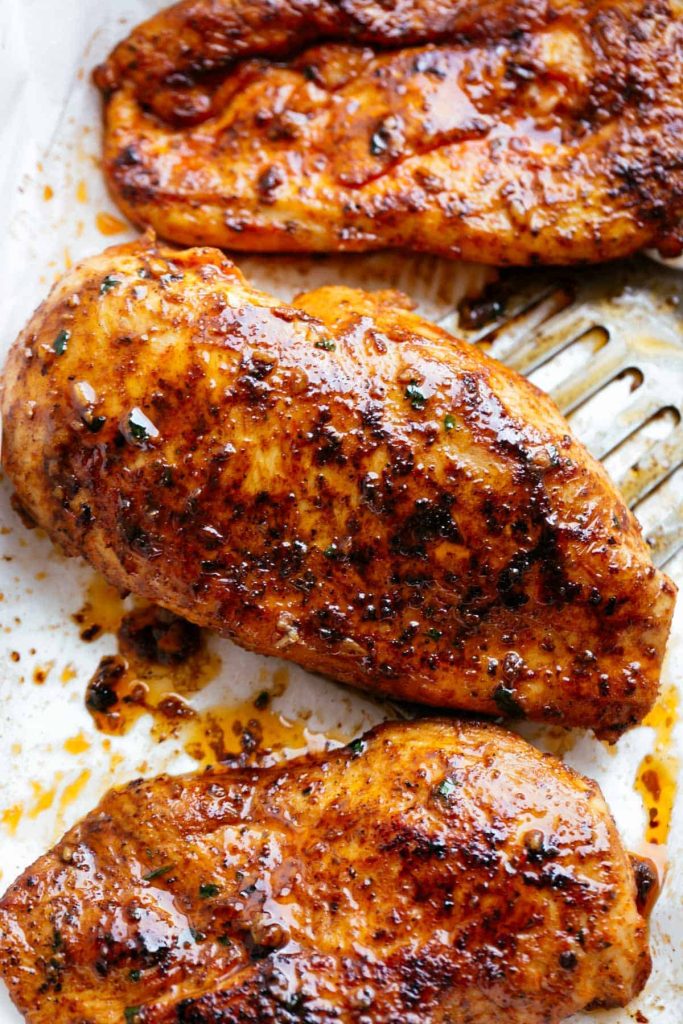
Chicken Breasts: Cook boneless, skinless chicken breasts in a preheated oven at 400°F (200°C) for 20-25 minutes or until they reach an internal temperature of 165°F (74°C).
Chicken Tenders: Cook chicken tenderloins in a preheated oven at 400°F (200°C) for 10-15 minutes or until they reach an internal temperature of 165°F (74°C).
Grilling or Barbecuing

Chicken Breasts: Grill chicken breasts over medium heat for 6-8 minutes per side until they are fully cooked and reach an internal temperature of 165°F (74°C).
Chicken Tenders: Grill chicken tenderloins over medium heat for 5-7 minutes per side until they are fully cooked and reach an internal temperature of 165°F (74°C).
Pan-Frying or Sautéing

Chicken Breasts: Cook boneless, skinless chicken breasts in a hot skillet with oil over medium heat for 6-8 minutes per side until they are golden brown and reach an internal temperature of 165°F (74°C).
Chicken Tenders: Pan-fry chicken tenderloins in a hot skillet with oil over medium heat for 4-7 minutes until they are no longer pink in the center and reach an internal temperature of 165°F (74°C).
Stuffed Chicken Breasts (if applicable): Ensure that the stuffing is fully cooked, and the internal temperature of the chicken reaches 165°F (74°C).
Salads
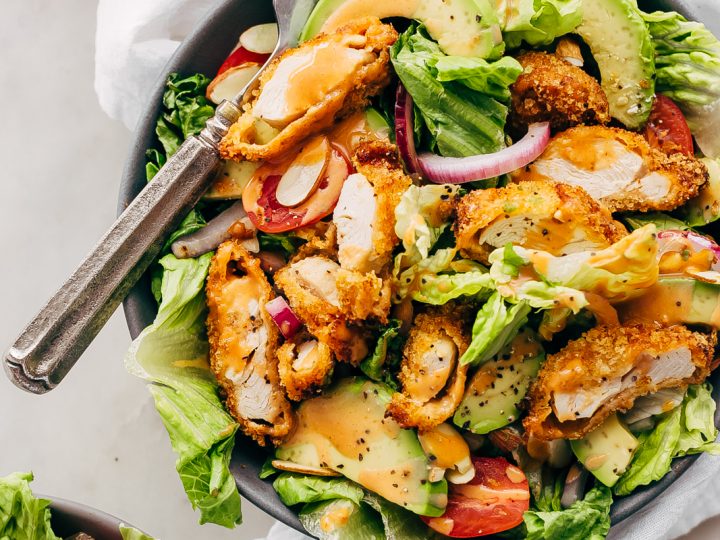
Cook and slice the tenderloins to add protein to your salads. Their tender texture pairs well with fresh greens and various dressings.
Remember these essential tips for cooking both cuts:
- To ensure food safety, cook chicken to an internal temperature of 165°F (74°C).
- Always use a meat thermometer to verify the internal temperature for food safety.
- Avoid overcooking to maintain tenderness and juiciness.
- Utilize marinades, rubs, or sauces to enhance the flavor and moistness of the chicken.
With these preparation and cooking methods, you can create an array of delectable dishes featuring chicken tenderloin and chicken breast.
Meals you can prepare with chicken breast and tenderloin.
Chicken breast and tenderloin are incredibly versatile cuts of poultry, allowing you to create a wide range of delicious and nutritious meals. Here are some popular dishes you can prepare using chicken breast and tenderloin:
Grilled Lemon Herb Chicken

Marinated chicken breasts grilled to perfection with a zesty lemon and herb flavor.
Chicken Stir-Fry
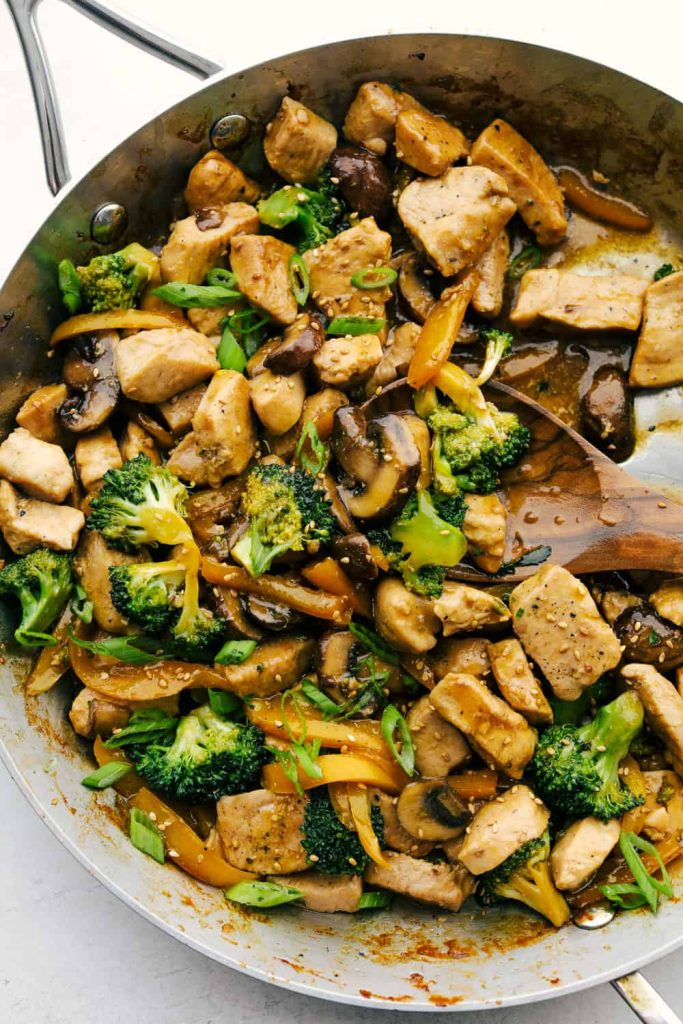
Sliced chicken tenderloins stir-fried with vegetables in a savory sauce, served over rice or noodles.
Chicken Parmesan
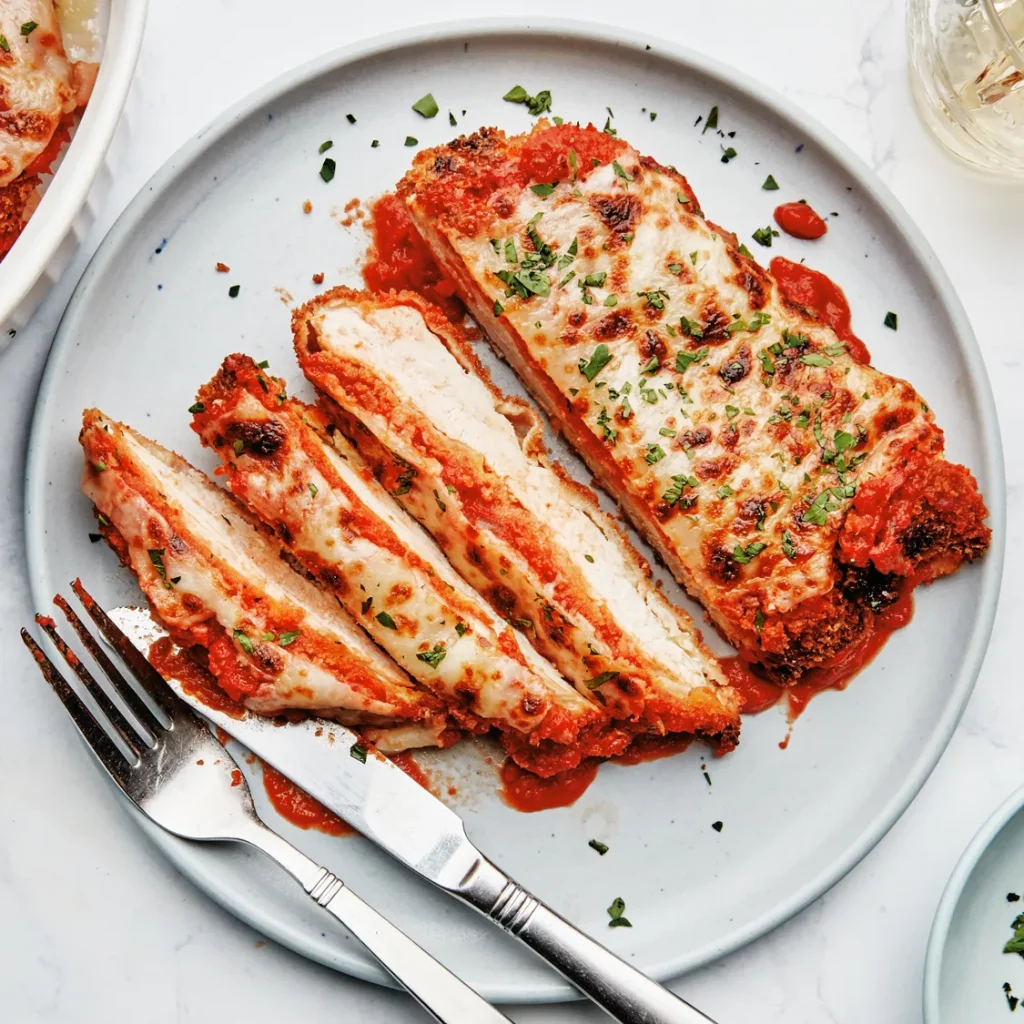
Breaded and baked chicken breasts topped with marinara sauce and melted cheese, served with pasta.
Chicken Skewers

Marinated chicken tenderloins threaded onto skewers with colorful vegetables and grilled for a delightful meal.
Chicken Alfredo
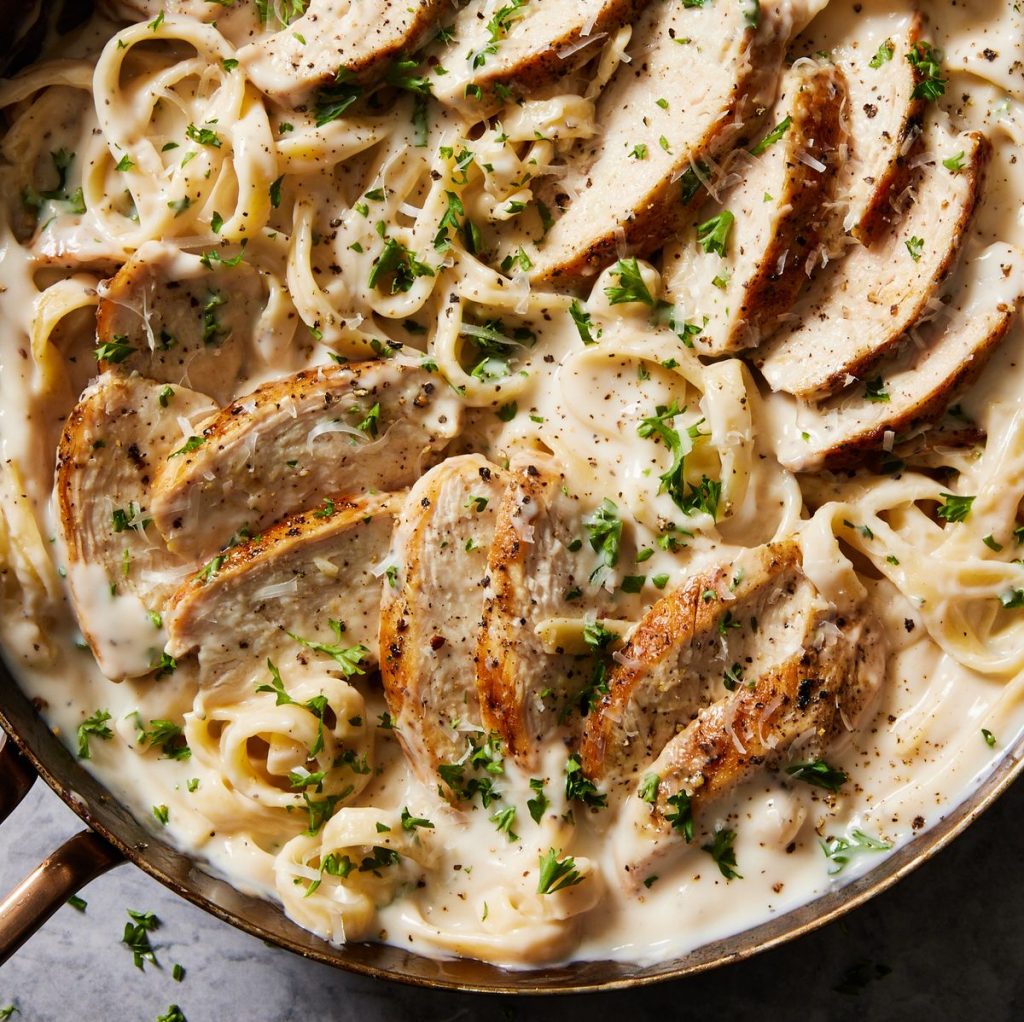
Sliced grilled chicken breast served over creamy Alfredo pasta for a comforting and satisfying dish.
Chicken Caesar Salad

Grilled or roasted chicken breast slices served over crisp romaine lettuce, Caesar dressing, croutons, and Parmesan cheese.
Honey Mustard Chicken Salad

Grilled or baked chicken tenderloins served over a bed of greens with honey mustard dressing.
Chicken Fajitas

Sliced chicken breast cooked with bell peppers and onions, served with tortillas and your favorite fajita toppings.
Chicken Satay

Marinated and grilled chicken tenderloins served with peanut sauce and cucumber salad for an Asian-inspired delight.
Chicken Lettuce Wraps
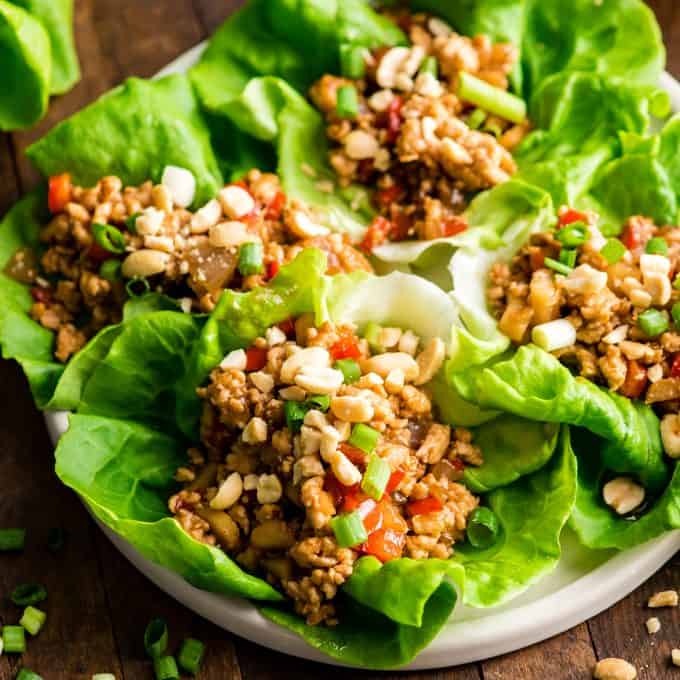
Ground or chopped chicken tenderloins cooked with flavorful Asian seasonings, served in lettuce cups for a light and refreshing meal.
These are just a few examples, and the possibilities are endless. You can also use chicken breast and tenderloin in soups, stews, sandwiches, quesadillas, and many more dishes.
Feel free to get creative with your seasonings, marinades, and sides to tailor these meals to your taste preferences and dietary needs.
Frequently Asked Question
Chicken tenderloins are more expensive due to their exceptional tenderness, as they are the small, tender strips of meat located under the chicken breast, making them a premium cut sought after for their delicate texture and convenience in cooking.
Chicken tenderloin and chicken breast are both nutritious choices, offering high-quality protein and essential nutrients. While tenderloins are slightly leaner, the nutritional difference is minimal, making both cuts excellent options for a balanced diet.
Chicken tenderloin generally contains slightly less cholesterol than chicken breast, but the difference is minimal as both cuts are relatively low in cholesterol and considered healthy choices when consumed as part of a balanced diet.
The chicken skin, regardless of the part, is often considered the unhealthiest as it is high in saturated fat and calories. Removing the skin before cooking can significantly reduce the overall fat content and improve the healthiness of the meal.
The tastiest part of the chicken is subjective and varies among individuals, but many people consider the chicken thigh, especially the bone-in and skin-on version, to be the most flavorful and juiciest part of the bird.
Related Articles
Top 60 Fast Foods Chains in America
McDonald’s Chicken Big Mac is returning
How to Cook Chicken Pepper Soup
Crispy Fried Chicken Drumsticks can be delicious.
Conclusion
In conclusion, both chicken tenderloin and chicken breast possess distinct qualities that cater to different culinary preferences.
Chicken tenderloin’s tenderness and rapid cooking time make it an ideal choice for quick and flavorful stir-fries, grilling, and finger foods.
Meanwhile, chicken breast’s heartier texture and versatility excel in a wide range of dishes, from baked and grilled delicacies to comforting soups and salads. Ultimately, the preferred cut depends on the specific recipe, cooking method, and personal taste.
Whichever option you choose, both cuts provide a nutritious source of lean protein.
Embrace your culinary creativity, experiment with seasonings and techniques, and savor the delightful flavors and textures of these remarkable poultry cuts.
Let the competition of chicken tenderloin versus breast inspire your culinary adventures, elevating your meals with wholesome goodness and irresistible appeal!
